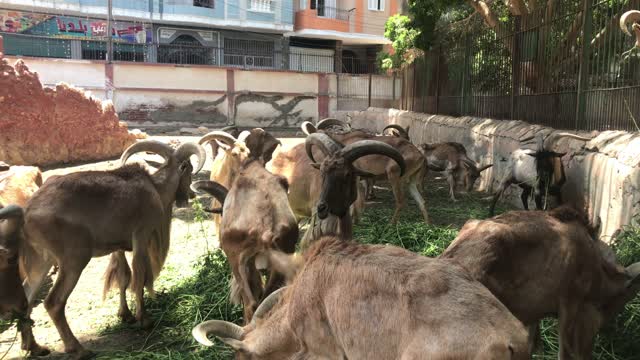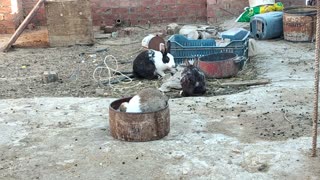Premium Only Content

Barbary Sheep in the Zoo
The Barbary sheep or aoudad is a species of caprid native to rocky mountains in North Africa. Six subspecies have been described. Although it is rare in its native North Africa, it has been introduced to North America, southern Europe, and elsewhere. It is also known in the Berber language as awdad, waddan, arwi, and arrwis.
Barbary sheep stand 80 to 100 cm (2.6 to 3.3 ft) tall at the shoulder and weigh 40 to 140 kg (88 to 309 lb). They are sandy-brown, darkening with age, with a slightly lighter underbelly and a darker line along the back. Upper parts and the outer parts of the legs are a uniform reddish brown or grayish brown. There is some shaggy hair on the throat (extending down to the chest in males) and a sparse mane. Their horns have a triangular cross section. The horns curve outward, backward, then inward, and can exceed 40 inches in length. The horns are fairly smooth, with slight wrinkles evident at the base as the animal matures.
Barbary sheep naturally occur in northern Africa in Algeria, Tunisia, northern Chad, Egypt, Libya, northern Mali, Mauritania, Morocco, Niger and Sudan (west of the Nile, and in the Red Sea Hills east of the Nile).
Barbary sheep have been introduced to southeastern Spain, the southwestern United States (Chinati Mountains on La Escalera Ranch, Guadalupe Mountains National Park, Palo Duro Canyon, the Trans-Pecos, and other parts of Texas, New Mexico, and California), Niihau Island (Hawaii), Mexico, and some parts of Africa.[citation needed]
They have become common in a limited region of south-eastern Spain, since its introduction in 1970 to Sierra Espuña [Regional park] as a game species. Its adaptability enabled it to colonise nearby areas quickly, and private game estates provided other centers of dispersion. The species is currently expanding, according to recent field surveys, now being found in the provinces of Alicante, Almería, Granada, and Murcia.This species is a potential competitor to native ungulates inhabiting the Iberian Peninsula. The species has also been introduced to La Palma (Canary Islands), and has spread throughout the northern and central parts of the island, where it is a serious threat to endemic vegetation.
-
 0:21
0:21
Beautiful_Animals_And_Birds
5 years agoA cute bunny sits on a plate
84 -
 2:03:51
2:03:51
TimcastIRL
9 hours agoTrans Minneapolis Shooter BLAMED Massacre On Mom & Gender Transition | Timcast IRL
193K355 -
 47:29
47:29
Man in America
16 hours agoIT DOESN'T ADD UP: The Trans Shooter's Story Is FULL of Holes
63.4K67 -
 3:59:36
3:59:36
StevieTLIVE
9 hours agoFriday Night Warzone HYPE
46.7K1 -
 3:47:10
3:47:10
SynthTrax & DJ Cheezus Livestreams
1 day agoFriday Night Synthwave 80s 90s Electronica and more DJ MIX Livestream Michael Jackson / AI Art Compilation Edition
54.6K2 -
 1:03:57
1:03:57
Sarah Westall
9 hours agoMara Lago Accord Joins the Fed, Fed Waves the White Flag & more w/ Andy Schectman
36K3 -
 2:44:12
2:44:12
I_Came_With_Fire_Podcast
1 day ago*BREAKING* Special Guest Katarina Szulc
45.8K10 -
 3:22:20
3:22:20
megimu32
9 hours agoOFF THE SUBJECT: FAFO Friday! Bodycams & Mario Kart Mayhem!
30.5K6 -
 55:36
55:36
Flyover Conservatives
1 day ago4 Strategies to Create Opportunity from Nothing - Clay Clark | FOC Show
33.7K1 -
 1:49
1:49
Gaming on Rumble
15 hours agoWhat is the Rumble Creator Program!?!? (Active Premium Creators) | Lvl UP
31.1K2